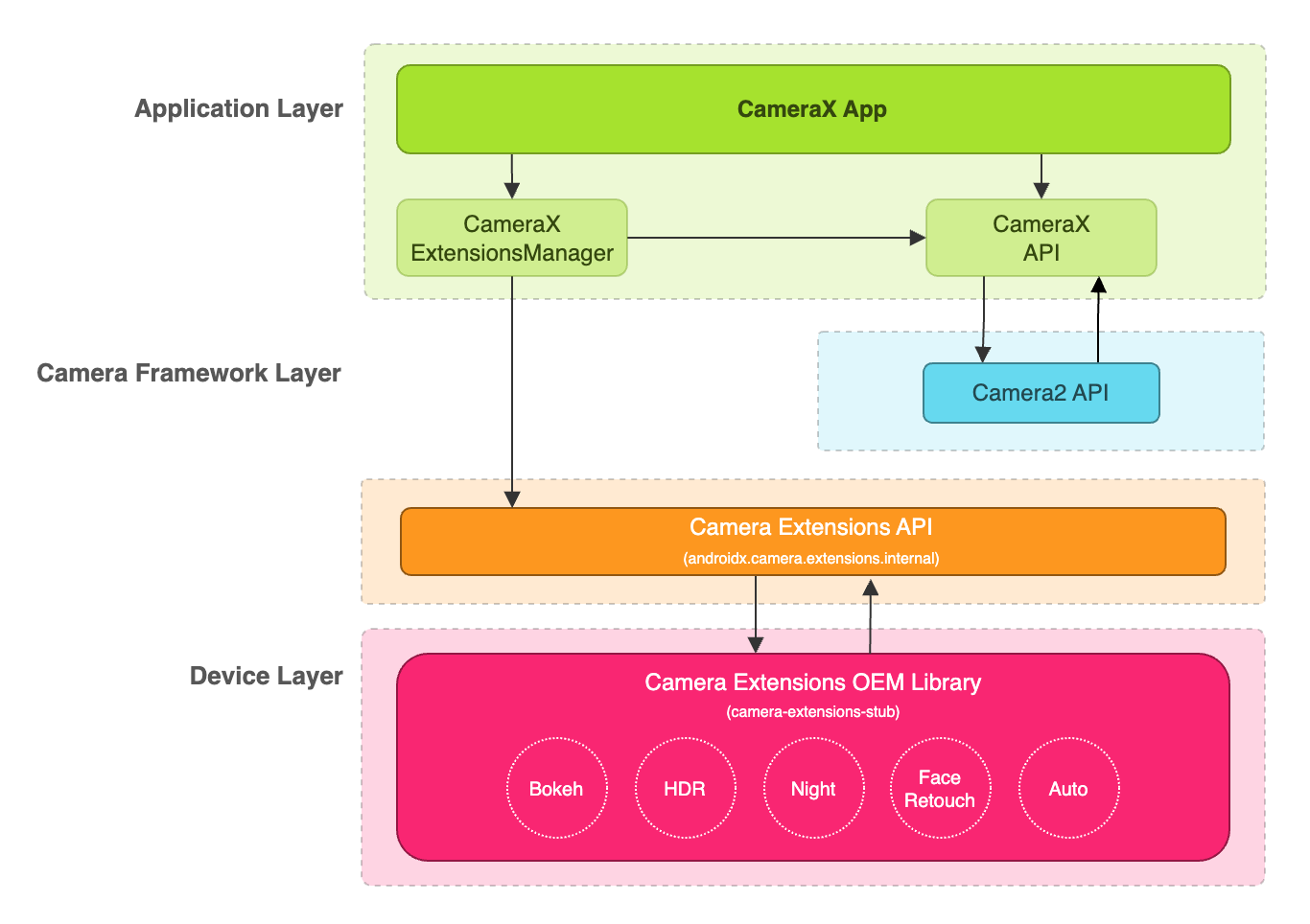CameraX には、デバイスのメーカーが各種 Android デバイスに実装した拡張機能にアクセスするための Extensions API が用意されています。サポートされている拡張機能モードの一覧については、カメラの拡張機能についての説明をご覧ください。
拡張機能をサポートするデバイスの一覧については、サポートされているデバイスについての説明をご覧ください。
拡張機能のアーキテクチャ
次の図は、カメラの拡張機能のアーキテクチャを示しています。

CameraX アプリは、CameraX Extensions API を通じて拡張機能を使用できます。CameraX Extensions API は、利用可能な拡張機能の照会、拡張機能カメラ セッションの構成、Camera Extensions OEM ライブラリとの通信を管理します。これにより、アプリは夜景、HDR、オート、ボケ、顔写真加工などの機能を使用できます。
画像キャプチャとプレビューの拡張機能を有効にする
Extensions API を使用する前に、ExtensionsManager#getInstanceAsync(Context、CameraProvider)メソッドを使用して ExtensionsManager インスタンスを取得します。これにより、拡張機能の可用性情報をクエリできます。次に、拡張機能が有効になっている CameraSelector を取得します。CameraSelector 拡張機能を有効にして bindToLifecycle() メソッドを呼び出すとき、画像キャプチャとプレビューのユースケースに拡張機能モードが適用されます。
画像キャプチャとプレビューのユースケースの拡張機能を実装するには、次のコードサンプルをご覧ください。
Kotlin
import androidx.camera.extensions.ExtensionMode import androidx.camera.extensions.ExtensionsManager override fun onCreate(savedInstanceState: Bundle?) { super.onCreate(savedInstanceState) val lifecycleOwner = this val cameraProviderFuture = ProcessCameraProvider.getInstance(applicationContext) cameraProviderFuture.addListener({ // Obtain an instance of a process camera provider // The camera provider provides access to the set of cameras associated with the device. // The camera obtained from the provider will be bound to the activity lifecycle. val cameraProvider = cameraProviderFuture.get() val extensionsManagerFuture = ExtensionsManager.getInstanceAsync(applicationContext, cameraProvider) extensionsManagerFuture.addListener({ // Obtain an instance of the extensions manager // The extensions manager enables a camera to use extension capabilities available on // the device. val extensionsManager = extensionsManagerFuture.get() // Select the camera val cameraSelector = CameraSelector.DEFAULT_BACK_CAMERA // Query if extension is available. // Not all devices will support extensions or might only support a subset of // extensions. if (extensionsManager.isExtensionAvailable(cameraSelector, ExtensionMode.NIGHT)) { // Unbind all use cases before enabling different extension modes. try { cameraProvider.unbindAll() // Retrieve a night extension enabled camera selector val nightCameraSelector = extensionsManager.getExtensionEnabledCameraSelector( cameraSelector, ExtensionMode.NIGHT ) // Bind image capture and preview use cases with the extension enabled camera // selector. val imageCapture = ImageCapture.Builder().build() val preview = Preview.Builder().build() // Connect the preview to receive the surface the camera outputs the frames // to. This will allow displaying the camera frames in either a TextureView // or SurfaceView. The SurfaceProvider can be obtained from the PreviewView. preview.setSurfaceProvider(surfaceProvider) // Returns an instance of the camera bound to the lifecycle // Use this camera object to control various operations with the camera // Example: flash, zoom, focus metering etc. val camera = cameraProvider.bindToLifecycle( lifecycleOwner, nightCameraSelector, imageCapture, preview ) } catch (e: Exception) { Log.e(TAG, "Use case binding failed", e) } } }, ContextCompat.getMainExecutor(this)) }, ContextCompat.getMainExecutor(this)) }
Java
import androidx.camera.extensions.ExtensionMode; import androidx.camera.extensions.ExtensionsManager; @Override protected void onCreate(Bundle savedInstanceState) { super.onCreate(savedInstanceState); final LifecycleOwner lifecycleOwner = this; final ListenableFuturecameraProviderFuture = ProcessCameraProvider.getInstance(getApplicationContext()); cameraProviderFuture.addListener(() -> { try { // Obtain an instance of a process camera provider // The camera provider provides access to the set of cameras associated with the // device. The camera obtained from the provider will be bound to the activity // lifecycle. final ProcessCameraProvider cameraProvider = cameraProviderFuture.get(); final ListenableFuture extensionsManagerFuture = ExtensionsManager.getInstanceAsync(getApplicationContext(), cameraProvider); extensionsManagerFuture.addListener(() -> { // Obtain an instance of the extensions manager // The extensions manager enables a camera to use extension capabilities available // on the device. try { final ExtensionsManager extensionsManager = extensionsManagerFuture.get(); // Select the camera final CameraSelector cameraSelector = CameraSelector.DEFAULT_BACK_CAMERA; // Query if extension is available. // Not all devices will support extensions or might only support a subset of // extensions. if (extensionsManager.isExtensionAvailable( cameraSelector, ExtensionMode.NIGHT )) { // Unbind all use cases before enabling different extension modes. cameraProvider.unbindAll(); // Retrieve extension enabled camera selector final CameraSelector nightCameraSelector = extensionsManager .getExtensionEnabledCameraSelector(cameraSelector, ExtensionMode.NIGHT); // Bind image capture and preview use cases with the extension enabled camera // selector. final ImageCapture imageCapture = new ImageCapture.Builder().build(); final Preview preview = new Preview.Builder().build(); // Connect the preview to receive the surface the camera outputs the frames // to. This will allow displaying the camera frames in either a TextureView // or SurfaceView. The SurfaceProvider can be obtained from the PreviewView. preview.setSurfaceProvider(surfaceProvider); cameraProvider.bindToLifecycle( lifecycleOwner, nightCameraSelector, imageCapture, preview ); } } catch (ExecutionException | InterruptedException e) { throw new RuntimeException(e); } }, ContextCompat.getMainExecutor(this)); } catch (ExecutionException | InterruptedException e) { throw new RuntimeException(e); } }, ContextCompat.getMainExecutor(this)); }
拡張機能を無効にする
ベンダー拡張機能を無効にするには、すべてのユースケースをアンバインドし、画像キャプチャとプレビューのユースケースを通常のカメラセレクタで再バインドします。たとえば、CameraSelector.DEFAULT_BACK_CAMERA を使用して背面カメラに再バインドします。
依存関係
CameraX の Extensions API は、camera-extensions ライブラリに実装されています。拡張機能は CameraX コアモジュール(core、camera2、lifecycle)に依存します。
Groovy
dependencies { def camerax_version = "1.2.0-rc01" implementation "androidx.camera:camera-core:${camerax_version}" implementation "androidx.camera:camera-camera2:${camerax_version}" implementation "androidx.camera:camera-lifecycle:${camerax_version}" //the CameraX Extensions library implementation "androidx.camera:camera-extensions:${camerax_version}" ... }
Kotlin
dependencies { val camerax_version = "1.2.0-rc01" implementation("androidx.camera:camera-core:${camerax_version}") implementation("androidx.camera:camera-camera2:${camerax_version}") implementation("androidx.camera:camera-lifecycle:${camerax_version}") // the CameraX Extensions library implementation("androidx.camera:camera-extensions:${camerax_version}") ... }
以前の API の削除
1.0.0-alpha26 での新しい Extensions API のリリースに伴い、2019 年 8 月にリリースされた以前の Extensions API のサポートは終了しました。バージョン 1.0.0-alpha28 以降、以前の Extensions API はライブラリから削除されています。新しい Extensions API を使用するアプリは、拡張機能が有効な CameraSelector を取得し、ユースケースをバインドする際に使用する必要があります。
以前の Extensions API を使用しているアプリは、今後の CameraX のリリースとの将来的な互換性を確保するために、新しい Extensions API に移行する必要があります。
参考情報
CameraX について詳しくは、以下の参考情報をご確認ください。
Codelab
